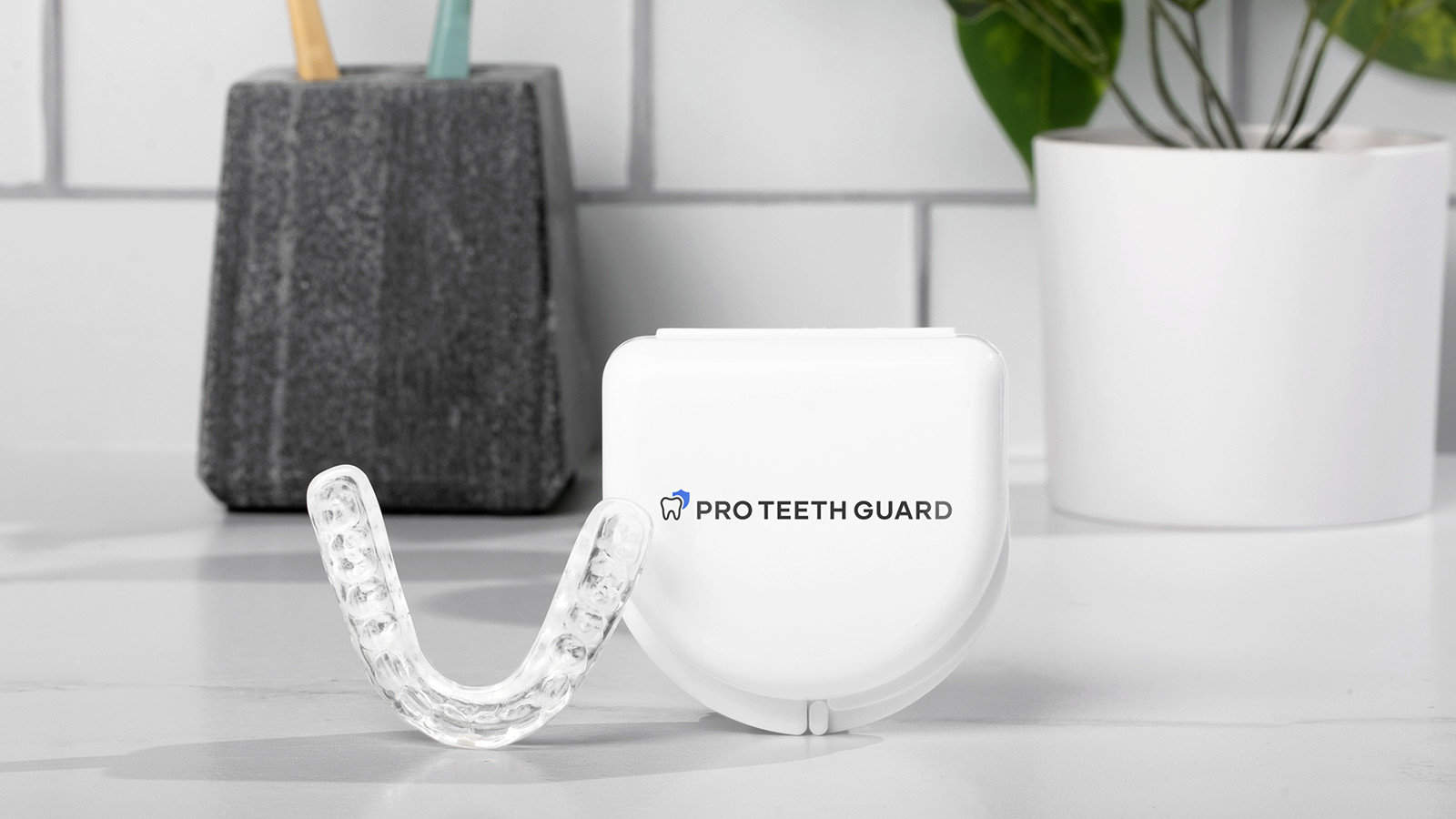Your journey to a perfectly molded mouthguard is not just about protecting your pearly whites; it’s also about ensuring you can wear it comfortably while confidently defending your smile.
For a mouthguard to be as comfortable and practical as possible, properly following the molding instructions is essential. A properly fitted mouthguard guarantees you can breathe and speak comfortably while wearing it.
We’ll walk you through every step of how to mold a mouthguard in this detailed guide.
Let’s get started!
Table of Contents:
- Pre-Molding Preparations
- How to Mold a Mouthguard With Hot Water
- When Re-Molding a Mouthguard is Necessary?
- How to Mold a Mouthguard with Microwave
- Pros and Cons of Using Hot Water vs. a Microwave for Molding
- How Long Does It Take to Mold a Mouthguard
- Post-Molding Care for Grinding Guards
- How To Mold a Mouth Guard: Final Thoughts
Pre-Molding Preparations
You start by ensuring a mouthguard is the perfect fit for your unique smile. Here’s how you can assess and prepare it for the molding process:

Assess the Fit by Gently Biting Mouth Guard
- Ensure that your mouthguard is clean before putting it in your mouth. If you have an upper or lower mouthguard, place it in the orientation of your choice.
- Bite down gently to ensure the mouthguard is comfortably positioned over your teeth. The guard should cover your front teeth and fit tightly over your teeth. This guarantees a flawless fit and prevents any adverse side effects of mouth guards usage.
- Use your tongue to ensure there are no spots that stick out or have sharp edges that could hurt you. Feel for any rough areas on the mouthguard by running your fingers along its exterior.
- Shut your mouth and evaluate your general level of comfort. It should not feel overly tight or loose but somewhat snug. You should be able to breathe and speak naturally.
- Keep the mouthguard in for a few minutes to ensure you can tolerate it without discomfort.
Trim The Night Guard for Comfort
Don’t worry if your mouthguard fits poorly or you find it unpleasant. For a more personalized fit, you can modify it. Here’s how you do it:
- Three items are required: a marker or pen, sharp scissors, and a mouthguard.
- Mark the places where your mouthguard extends past your teeth once it’s securely in place. These are the sections you’ll cut.
- Cut off any surplus material with caution using sharp scissors. It’s better to make tiny incisions than big ones while trimming. Do one-quarter of an inch at a time, roughly trim.
- Return the mouth guard to your mouth and lightly bite down after each trim. Inspect for better fit and comfort. It might require multiple tests and trimming until it’s perfect.
- Once a suitable fit has been achieved, smooth off any sharp or uneven edges with fine-grit sandpaper.
How to Mold a Mouthguard With Hot Water
You can mold a mouthguard with hot water to guarantee a snug and comfortable fit. Follow this step-by-step steps:
Content team: add visual aids like images or videos to illustrate each step.
Step 1: Boiling the Water
- Boil water for molding before you start. The water is for the material to soften.
- Use a spotless saucepan or pot deep enough to submerge the mouthguard completely.
- Pour enough water into the saucepan to cover the mouthguard. Don’t fill it to the brim.
- Set the pot over a stovetop burner and bring the water up to a rolling boil.
Step 2: The Hot Water Dip
Get ready to start the molding process:
- To avoid burns, hold the mouthguard using tongs or oven mitts.
- Put the mouthguard in the boiling water. Ensure it’s completely submerged for half a minute. The material will soften and become pliable.
- Pay careful attention to the time. For most mouthguards, 30 seconds is plenty of time. Don’t soak too much to prevent being overly mushy and losing shape.
Step 3: Cooling Off
Once you’ve dipped the mouthguard in hot water, it’s time to cool it down:
- Carefully remove the mouthguard from the boiling water using tongs or a spoon.
- Using your mouth, gently bite down on the mouthguard. To press the edges of your teeth, use your fingertips. This allows the mouthguard to adjust to the shape of your teeth.
- Give the guard time to settle and cool while still in your mouth. It takes a minute or two to complete. Keep your mouth shut and don’t move during this stage to guarantee a fit mouthguard. And in the meantime, check out our top rated mouth guards for teeth grinding.
Special Instructions:
⚠️ Always exercise caution when working with hot water to avoid burns or scalding.
⚠️ Make sure to speak to your orthodontist before trying to create a mouth guard if you wear braces. Given that the procedures may vary, they can advise on appropriate choices, especially if you wear mouth guards with braces.
When Re-Molding a Mouthguard is Necessary?
There are instances when you might find it necessary to re-mold your mouthguard, whether a sports mouthguard or a night guard. Here are a few common instances:
- Re-mold your mouth guard if you feel that it irritates your mouth or feels uncomfortable to wear. Also consider remolding if mouthguards you are using lose shape and fit due to wear and tear.
- If you’re wearing braces or other dental appliances, the shape of your mouth may change after the treatment. In these situations, it’s best to re-mold your mouthguard to ensure it keeps its tight fit.
- It’s also recommended to remold the mouth guard, if you’ve sustained a significant impact while wearing it. Re-molding guarantees that its protective properties are preserved. However, if your night guard was visibly damaged, it would be best to replace it.
In cases, when you cannot remold your appliance and require a replacement, check out our hand-picked choices!

One of the best night guards for TMJ disorder treatment because of a large selection of different thickness options.
- Many thickness options
- Well-constructed impression kit
- Fast shipping
How to Re-Mold a Night Guard
Re-molding a night guard is similar to the initial molding process, with some subtle differences. Here’s how to re-mold acrylic night guards:
- Give your night guard a thorough cleaning to remove any dirt, bacteria, or leftovers from prior usage. Finish with a deep rinse and pat it dry.
- Bring a pot of water to a boil. Ensure there is a rolling boil.
- Dip the night guard into the boiling water using tongs or a sliding spoon. To make the material softer, leave it there for around thirty seconds.
- Take off the night guard with caution and give it some time to cool. Then, put it in your mouth and bite down. For a tight fit, press the material with your fingertips on your teeth and gums.
- Give the night guard a minute or two in your mouth to settle and cool by the structure of your teeth. Don’t open your mouth or speak during this period.
- After re-molding, you can use scissors to carefully clip any uncomfortable edges on the night guard and fine-grit sandpaper to smooth them down. (if necessary)
How to Mold a Mouthguard with Microwave
If you prefer to use a microwave for molding your mouthguard, follow these steps to ensure you get maximum usage of your mouth guard:
The Microwave Dip
- Have enough water in a microwave-safe bowl to submerge the mouthguard completely.
- Heat the water to a boiling point. Depending on the power of your microwave, the precise duration may change, but it usually takes one to two minutes.
- After the water reaches a rolling boil, place the mouthguard inside using a slotted spoon or a similar tool.
- Give it around 30 seconds to sit in the hot water. As a result, the material will become softer and more moldable. Don’t over-soak, so the mouthguard isn’t too soft.
- Remove the mouthguard from the boiling water using the slotted spoon. Place it in your mouth and line it up with your teeth. To get a snug fit, bite down softly and press the material against your teeth and gums with your fingertips.
- Have your mouthguard sit in your mouth for a minute or two to cool and set to the shape of your teeth. To guarantee a precise fit, don’t talk or move your mouth during this period.
Pros and Cons of Using Hot Water vs. a Microwave for Molding
Here are the pros and cons of using hot water or a microwave for molding your mouthguard.
| Hot Water Molding | Microwave Molding | |
| Convenience | Requires a stovetop | Quick and simple |
| Temperature Control | Need to monitor heat | Easier temperature control |
| Risk of Overheating | It’s possible | Lower risk |
| Preparation Time | Takes longer | It’s shorter |
How Long Does It Take to Mold a Mouthguard
Below is a breakdown of the amount of time required for each step, which sums up, that on average, it should around 10 minutes for you to mold a mouth guard:
- Boiling the Water: Bringing the water to a rolling boil typically takes five to seven minutes.
- The Hot Water Dip: It’s a fast step that takes around 30 seconds.
- Cooling Off: It takes one to two minutes for the mouthguard to cool down for safe handling and molding.
- Mouth Molding: It typically takes one to two minutes for your mouth to shape.
Post-Molding Care for Grinding Guards
Maintaining the efficacy and longevity of your newly formed mouth guard is crucial, particularly if you suffer from bruxism, also known as teeth grinding. Here are some post-molding care tips:
- Rinse your mouthguard with cold water after every use to eliminate debris, bacteria, or saliva. It keeps it odor-free and clean.
- Give your guard a deep cleaning at least once a week. Use a soft toothbrush, a mouthguard cleaner, mild soap, or a special cleaning solution.
- Keep the guard in a dry, clean container when not in use. It may deform if exposed to strong sunlight or extremely cold conditions.
- Ensure your mouthguard is regularly free of wear and tear. Check for any rips, cracks, or form changes. For ongoing protection, think about replacing it if you see any of these problems.
- Avoid biting into your mouthguard. Chewing may change the fit and cause premature wear.
- Ask your dentist or orthodontist for help if you feel uncomfortable or notice any changes to the structure of your teeth while wearing the mouthguard.
How To Mold a Mouth Guard: Final Thoughts
A properly fitted mouthguard is essential for a comfortable and secure smile, regardless of whether you grind your teeth at sleep or are an active athlete. If you know enough and work hard enough, you may create a bespoke fit that’s comfortable and protective. Remember, maintaining your mouthguard correctly and getting regular checks to ensure it keeps working effectively comes after you’ve molded it.

